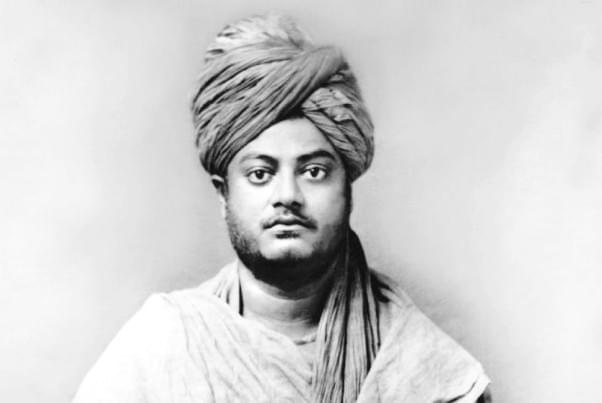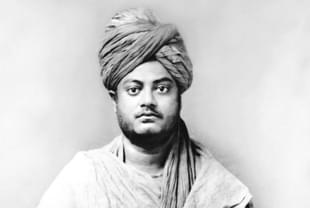Ideas
Objection Over Vivekananda Statue At JNU Betrays A Narrow Vision Of Indian History
Saurabh Sharma
Dec 29, 2018, 08:24 PM | Updated 08:24 PM IST
Save & read from anywhere!
Bookmark stories for easy access on any device or the Swarajya app.


Jawaharlal Nehru University (JNU) again courted controversy recently when left-affiliated student groups in the institution protested against the decision of the administration to place a statue of Swami Vivekananda on campus. The protest is not just against the statue but what the left believes it symbolises – a resurgence of Hindutva politics.
It is not uncommon for the left wing, whether in India or beyond, to celebrate their icons through statues and memorials and so they might not be entirely unaware of the inner consciousness that houses itself in any art and sculpture. But what they could be missing is the ‘root metaphor’ that houses itself in such installations.
The word “image” comes from the old Latin and French word “imago”, which closely resembles the connotation of “likeness”. The word image has a close parallel in Indian words like prakriti, pratima, vimba. The word “vimba” means reflection and it is used to resemble the images of divinities.
In Bengal, at the time of the annual autumnal worship of goddess Durga’s clay images, a mirror seated on a copper or brass bowl is placed in front of the deity in such a way that the image can be reflected in the mirror and then the water, called snana-jala, for bathing the deity is poured on the reflection in the mirror. This way the ritual bathing is conducted realising the true meaning of the word “vimba”, or as one may say, “likeness”.
In Indic parlance, statues of divinities, great men and women, or ancestors each have a root metaphor that make the sculpture more than just a piece of stone or wood and infuses it with a philosophy, a likeness, or what Stephen Pepper calls ‘root metaphor’.
So, while the left can only see politics in the statue, an Indic engagement would entail decoding the ‘root metaphor’ reflective in the life and work of Vivekananda and that would explain why the statue deserves a place of prominence at JNU.
Vivekananda And The Confluence Of Indic Thought And Scientific Temperament
Few people know that Vivekananda, apart from ushering in a Vedic renaissance, played a key role in making the West aware of the areas of convergence between Vedic thought and scientific temperament. His life and work were critical to convincing the Western world that India is not a nation of uncivilised people with barbaric practices. He emphasised that there is no chaotic world here that needs to be civilised by converting people to Christianity.
An interesting example of Vivekananda’s understanding of the science in the Vedas is the influence he had on Nikola Tesla. The inventor was taken in by the monk’s work that he started using Sanskrit terminology while working on his scientific investigations and tweaked his way of looking for the secrets of the universe. Tesla was introduced to Vivekananda through actress Sarah Bernhardt, and after that he pursued the coded scientific language of Vedas with all sincerity.
Vivekananda mentions Tesla in one of his letters dated 13 February 1896:
Mr. Tesla was charmed to hear about the Vedantic Prana and Akasha and the Kalpas. He thinks he can demonstrate mathematically that force and matter are reducible to potential energy. I am to go to see him next week to get this mathematical demonstration. In that case, Vedantic cosmology will be placed on the surest of foundations. I clearly see their perfect union with modern science, and the elucidation of one will be followed by that of the other.
It is not that Vivekananda’s observation of Tesla’s interest was one-sided; this can be confirmed through one of Tesla’s posthumously published articles called “Man’s Greatest Achievement” (1907), where he writes using Vedantic terminology.
Long ago… [Mankind] recognized that all perceptible matter comes from a primary substance, or tenuity beyond conception, filling all space, the Akasha or luminiferous ether, which is acted upon by the life-giving Prana or creative force, calling into existence, in never ending cycles all things and phenomena. The primary substance, thrown into infinitesimal whirls of prodigious velocity, becomes gross matter; the force subsiding, the motion ceases and matter disappears, reverting to the primary substance.
The meanings of ‘prana’ and ‘akasha’ here can be approximated to ‘vital life force’ and ‘ether’ respectively. Tesla points to the projected reality that is described in the philosophical sections of the Vedas, called Upanishads. The world that we see and perceive around us is called ‘maya’ (can also be understood as “illusionary matrix”). Upanishads say this is made from the three qualities of sattva, rajas, and tamas. Tamas produces itself as veiling power, rajas as projecting power, and sattva as revealing power.
Upanishads say that to come out of this maze and realise the primary substance, one has to have the “revealing power”, which, because of the other two qualities, has turned into the infinitesimal whirls of prodigious velocity presenting itself to you as maya.
The science and wisdom of the Upanishads and Vedas are not a wishful fantasy about the ancient days. Noted theoretical physicist E C G Sudarshan, born in Kerala, later called himself a “Vedantin Hindu”. In an interview to a newspaper, he said he finds a lot of parallels between Vedanta and modern science, and asserts that:
Once you bring subjective experience into the picture, science finds close parallels with Indian philosophy. The Upanishads go to a great depth on topics of space, time the nature of causality and such. Unlike science, the analysis found in the Upanishads is entirely from an inside point of view. I find that approach reasonable and a lot refreshing.The Hindu, 24 January 2013
Even till this day, Vivekananda’s influence can be seen among many in the scientific community. John Dobson, a pioneering astronomer best known for making a Newtonian reflector telescope famously known as the Dobsonian telescope, puts his respect for Vivekananda in this way:
Swami Vivekananda said that he could write a whole paragraph on a single statement of Sri Ramakrishna, and I could write a whole book on this single statement of the Swami.
JNU is a university with strong and established scientific research credentials and a thriving community of teachers and students dedicated to the sciences. The uniqueness of Vivekananda’s exploration into the convergence of scientific and Vedic philosophy deserves to be celebrated at the institution. But sadly, tunnel vision would not allow the left to look beyond his Hindu identity or even give any serious thought to the richness of the line of scientific enquiry that he endorsed.
Vivekananda And Nationalism
Nationalism is a much-hated word in communist strongholds and it is understandable that any assertion of national identity would be considered toxic in those circles. But Vivekananda’s work in cementing a national identity and providing an articulation beyond the despondency of the imperial rule is precisely why his statue deserves a place at one of the largest national educational institutions in the country.
Vivekananda’s lifelong endeavours were once the reason for the impulsive stimulus in many freedom fighters, including Subhas Chandra Bose, Mahatma Gandhi, and Aurobindo Ghosh, all of whom later shook the foundations of the British Raj in India. His teachings of Vedas later manifested in Gandhi’s message of “ahimsa (non-violence)” and “satyagraha (insistence on truth)”.
The influence of Vivekananda’s teachings on his life was acknowledged and accepted by Gandhi. In his visit to Belur Math in 1921, Gandhi said, “I have come here (Belur Math) to pay my homage and respect to the revered memory of Swami Vivekananda, whose birthday is being celebrated today. I have gone through his works very thoroughly, and after having gone through them, the love that I had for my country became a thousand fold. I ask you, young men, not to go away empty-handed without imbibing something of the spirit of the place where Swami Vivekananda lived and died.”
Vivekananda’s nationalism was based on the spiritual teachings of the Vedas, which can be observed in his utterances:
“I am an Indian and every Indian is my brother.”
“The ignorant Indian, the poor and destitute Indian, the Brahmin Indian, the pariah Indian is my brother.”
“The Indian is my brother, the Indian is my life, India’s gods and goddesses are my God, India’s society is the cradle of my infancy, the pleasure garden of my youth, the sacred heaven, the Varanasi of my old age.”
“The soil of India is my highest heaven; the good of India is my good.”
Vivekananda articulated that the imperial rule was incompatible with the Indian spiritual destiny. He had a deep concern for the welfare of the masses and took the message of “karma yoga” to them. Karma yoga for him was an ethical system to attain both political and spiritual freedom and stirred the masses to snatch freedom from British profiteering.
The roots of Vivekananda’s articulation of nationalism, the absolute Indic lens of his philosophy, and his celebration of the soil might be points of contention for the left wing. Yet each of these reasons is a celebration of our identity, which deserves a place of prominence at JNU.
Some at the JNU appear to have forgotten that Vivekananda had once travelled across the length and breadth of the country barefoot to awaken the dormant consciousness of people who were stripped of their land and their rights by colonial powers.
Vivekananda was a one-man civil society that India witnessed at a crucial juncture of awakening. JNU as an institution of national repute was made for the very same purpose of producing scholars who will reach out to the corners of the globe and spread the true essence of humanity through their scientific and social endeavours.
The work that was once done by Vivekananda now needs to be done by the new scholars to pass out of this institution, and so, there could not be a bigger role model from whom to learn.
If a man like Vivekananda, who introduced India in its pristine glory to the West, is not given his place in the highest institution of Indian academics, then it will be a blot on the face of the Indian left.
It will be yet another example of their narrow, myopic understanding of India, its history, and its heroes.
Saurabh Sharma is a central working committee member of ABVP and former joint secretary of JNU Students’ Union.





